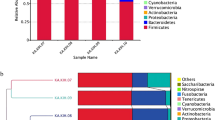Abstract
Bifidobacteria are commensal microorganisms able to colonize several ecological niches. Since their discovery, culture-dependent methods combined with the most modern next-generation sequencing techniques have contributed to shed light on the ecological, functional and genomic features of bifidobacteria, purporting them as microorganisms with probiotic traits. Thanks to their acclaimed health-promoting effects, several members of the Bifidobacterium genus have been included in a variety of functional foods and drugs. In this context, the functional relevance of bifidobacteria in the gut explains ongoing efforts to isolate novel and potentially beneficial strains. For this purpose, development of effective and selective isolation protocols in concert with knowledge on the physiological characteristics of bifidobacterial are fundamental requirements for their recovery and discovery from their natural environments, in particular from fecal samples.
Access this chapter
Tax calculation will be finalised at checkout
Purchases are for personal use only
Similar content being viewed by others
References
Alessandri G, Ossiprandi MC, MacSharry J, van Sinderen D, Ventura M (2019) Bifidobacterial dialogue with its human host and consequent modulation of the immune system. Front Immunol 10:2348
O'Callaghan A, van Sinderen D (2016) Bifidobacteria and their role as members of the human gut microbiota. Front Microbiol 7:925
Lugli GA, Milani C, Duranti S, Alessandri G, Turroni F, Mancabelli L, Tatoni D, Ossiprandi MC, van Sinderen D, Ventura M (2019) Isolation of novel gut bifidobacteria using a combination of metagenomic and cultivation approaches. Genome Biol 20:96
Milani C, Turroni F, Duranti S, Lugli GA, Mancabelli L, Ferrario C, van Sinderen D, Ventura M (2016) Genomics of the genus Bifidobacterium reveals species-specific adaptation to the glycan-rich gut environment. Appl Environ Microbiol 82:980–991
Pokusaeva K, Fitzgerald GF, van Sinderen D (2011) Carbohydrate metabolism in Bifidobacteria. Genes Nutr 6:285–306
Bottacini F, van Sinderen D, Ventura M (2017) Omics of bifidobacteria: research and insights into their health-promoting activities. Biochem J 474:4137–4152
Roy D (2001) Media for the isolation and enumeration of bifidobacteria in dairy products. Int J Food Microbiol 69:167–182
Nebra Y, Jofre J, Blanch AR (2002) The effect of reducing agents on the recovery of injured Bifidobacterium cells. J Microbiol Methods 49:247–254
Leahy SC, Higgins DG, Fitzgerald GF, van Sinderen D (2005) Getting better with bifidobacteria. J Appl Microbiol 98:1303–1315
Biavati B, Vescovo M, Torriani S, Bottazzi V (2000) Bifidobacteria: history, ecology, physiology and applications. Ann Microbiol 50:117–131
Serafini F, Bottacini F, Viappiani A, Baruffini E, Turroni F, Foroni E, Lodi T, van Sinderen D, Ventura M (2011) Insights into physiological and genetic mupirocin susceptibility in bifidobacteria. Appl Environ Microbiol 77:3141–3146
Laureys D, Cnockaert M, De Vuyst L, Vandamme P (2016) Bifidobacterium aquikefiri sp. nov., isolated from water kefir. Int J Syst Evol Microbiol 66:1281–1286
Alberoni D, Gaggia F, Baffoni L, Modesto MM, Biavati B, Di Gioia D (2019) Bifidobacterium xylocopae sp. nov. and Bifidobacterium aemilianum sp. nov., from the carpenter bee (Xylocopa violacea) digestive tract. Syst Appl Microbiol 42:205–216
Vlkova E, Salmonova H, Bunesova V, Geigerova M, Rada V, Musilova S (2015) A new medium containing mupirocin, acetic acid, and norfloxacin for the selective cultivation of bifidobacteria. Anaerobe 34:27–33
Lapierre L, Undeland P, Cox LJ (1992) Lithium chloride-sodium propionate agar for the enumeration of bifidobacteria in fermented dairy products. J Dairy Sci 75:1192–1196
Pacher B, Kneifel W (1996) Development of a culture medium for the detection and enumeration of bifidobacteria in fermented milk products. Int Dairy J 6:43–64
Modesto M, Satti M, Watanabe K, Puglisi E, Morelli L, Huang CH, Liou JS, Miyashita M, Tamura T, Saito S, Mori K, Huang L, Sciavilla P, Sandri C, Spiezio C, Vitali F, Cavalieri D, Perpetuini G, Tofalo R, Bonetti A, Arita M, Mattarelli P (2019) Characterization of Bifidobacterium species in feaces of the Egyptian fruit bat: description of B. vespertilionis sp. nov. and B. rousetti sp. nov. Syst Appl Microbiol 42:126017
Bunesova V, Vlkova E, Rada V, Rockova S, Svobodova I, Jebavy L, Kmet V (2012) Bifidobacterium animalis subsp. lactis strains isolated from dog faeces. Vet Microbiol 160:501–505
Novakova J, Vlkova E, Salmonova H, Pechar R, Rada V, Kokoska L (2016) Anticlostridial agent 8-hydroxyquinoline improves the isolation of faecal bifidobacteria on modified Wilkins-Chalgren agar with mupirocin. Lett Appl Microbiol 62:330–335
Sule J, Korosi T, Hucker A, Varga L (2014) Evaluation of culture media for selective enumeration of bifidobacteria and lactic acid bacteria. Braz J Microbiol 45:1023–1030
Miranda RO, de Carvalho AF, Nero LA (2014) Development of a selective culture medium for bifidobacteria, Raffinose-propionate lithium mupirocin (RP-MUP) and assessment of its usage with Petrifilm aerobic count plates. Food Microbiol 39:96–102
Lawson MAE, O'Neill IJ, Kujawska M, Gowrinadh Javvadi S, Wijeyesekera A, Flegg Z, Chalklen L, Hall LJ (2020) Breast milk-derived human milk oligosaccharides promote Bifidobacterium interactions within a single ecosystem. ISME J 14:635–648
Author information
Authors and Affiliations
Corresponding author
Editor information
Editors and Affiliations
Rights and permissions
Copyright information
© 2021 Springer Science+Business Media, LLC, part of Springer Nature
About this protocol
Cite this protocol
Alessandri, G., Ossiprandi, M.C., Ventura, M., van Sinderen, D. (2021). Protocol to Select Bifidobacteria from Fecal and Environmental Samples. In: van Sinderen, D., Ventura, M. (eds) Bifidobacteria. Methods in Molecular Biology, vol 2278. Humana, New York, NY. https://doi.org/10.1007/978-1-0716-1274-3_6
Download citation
DOI: https://doi.org/10.1007/978-1-0716-1274-3_6
Published:
Publisher Name: Humana, New York, NY
Print ISBN: 978-1-0716-1273-6
Online ISBN: 978-1-0716-1274-3
eBook Packages: Springer Protocols




